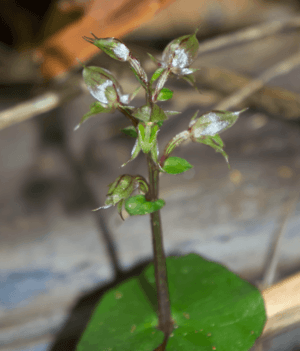Pixie caps facts for kids
Quick facts for kids Pixie caps |
|
|---|---|
 |
|
| In Kaimai Mamaku Conservation Park, New Zealand | |
| Scientific classification | |
| Genus: |
Acianthus
|
| Species: |
sinclairii
|
| Synonyms | |
|
Acianthus fornicatus var. sinclairii (Hook.f.) Hatch |
|
The pixie cap orchid, also known as Acianthus sinclairii, is a special type of flowering plant. It belongs to the orchid family, called Orchidaceae. This plant is found only in New Zealand, which means it is endemic there. It grows on the ground and has one leaf shaped like a heart. The plant can have up to ten green flowers that look a bit see-through. These flowers often have a reddish-brown color mixed in.
Contents
What the Pixie Cap Orchid Looks Like
The pixie cap orchid is a plant that grows from the ground. It lives for many years (it's a perennial plant). Its leaves die back in winter, but the plant grows again later (it's deciduous). It has a single, smooth, dark green leaf that looks like a heart. This leaf often has a reddish-brown color or marks on it.
The leaf is about 10–30 mm (0.4–1 in) long. It grows about a quarter to halfway up the plant's thin stem. The stem is about 100 mm (4 in) tall when the plant flowers. After flowering, the stem gets even taller.
The plant can have up to ten flowers. Each flower is about 6–8 mm (0.2–0.3 in) long. They are green with purple spots. The bottom part of the flower, called the labellum, is a dull red color.
The top part of the flower, called the dorsal sepal, looks like a wide spear or egg. It forms a small hood over the central part of the flower, which is called the column. The side sepals are about the same length as the top sepal. They have a pointed end and stick out forward, below the labellum.
The petals of the flower are a bit shorter than the sepals. They are shaped like spears and spread out wide. The labellum is also shorter than the sepals. It is shaped like a wide egg and is curved like a dish, with its edges turned under. It is dull red and has two round bumps, called calli, at its base. Pixie cap orchids usually flower between January and October.
How the Pixie Cap Orchid Got Its Name
The pixie cap orchid, Acianthus sinclairii, was first officially described in 1853. A famous botanist named Joseph Dalton Hooker wrote about it. His description was published in a book called Flora Antarctica.
Hooker noticed that this orchid was similar to another one, Acianthus fornicatus. But he saw that the pixie cap orchid's labellum (the lip of the flower) was different. The second part of its scientific name, sinclairii, was chosen to honor Andrew Sinclair. He was a Scottish botanist and a friend of Joseph Dalton Hooker.
Where the Pixie Cap Orchid Lives
This orchid usually grows in shady areas. You can find it in shrublands and forests. It does not often grow in sunny places. It often grows near streams or in wet areas.
The pixie cap orchid lives on both the North Island and the South Island of New Zealand. It also grows on Stewart Island, Chatham Islands, and Raoul Island. Raoul Island is part of the Kermadec Group.
Is the Pixie Cap Orchid in Danger?
Good news! The Acianthus sinclairii is a common plant. It is officially classified as "not threatened." This means it is not in danger of disappearing.

